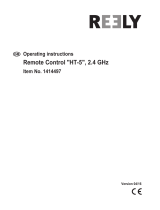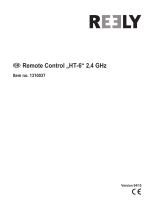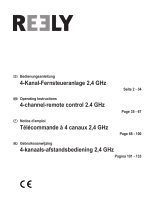Page is loading ...

2.4GHz FHSS
Radio System
Instruction Manual

CONTENTS
Transmitter
Receiver
Throttle/
Rudder
Stick
Elevator
Trim
On/O
Switch
Battery Cover
Charging
Socket
Reversing Switches
Mixer Switch
Rudder
Trim
Aileron
Trim
Throttle
Trim
Elevator/
Aileron
Stick
Battery
Indicators
PDM
Button
Remove the battery cover to
replace the transmitter batteries
by pressing the marked point
and sliding the cover o.
Channel Output
CH1 - Channel 1 (Aileron)
CH2 - Channel 2 (Elevator)
CH3 - Channel 3 (Throttle)
CH4 - Channel 4 (Rudder)
CH5 - Channel 5 (Aux 1)
CH6 - Channel 6 (Aux 2)
Aerial
Pair
Button
5th
Channel
6th
Channel

Receiver Aerial Installation
Transmitter Aerial
Pairing Procedure
To ensure the best range, the receiver aerial should be installed as far away from
conductive materials such as metal and carbon.
The aerial should be mounted away from any sources of electrical noise such as
motors and ESC. The receiver contains precision electronic parts. It is the most
delicate on-board radio component and must be protected from vibration, shock
and temperature extremes. To protect the receiver, wrap it in foam rubber or
similar vibration-absorbing material. Always protect the receiver from moisture
and both fuel and exhaust residue.
The transmitter aerial is adjustable. Please make sure it is never pointing directly at
the model as this reduces the signal strength to the receiver.
Always keep the aerial vertical to create the best RF conditions for your receiver.
Of course, this will depend on how you hold the transmitter, but in most cases,
adjusting the aerial so that it is pointing straight up will give the best results.
Never hold the aerial when the transmitter is in use as it can degrade the quality of
the signal.
There is a new pairing procedure for binding the receiver to the transmitter
Your transmitter and receiver are factory bound, but should you purchase a
second receiver, you will need to pair it to your transmitter.
1. Turn on the Transmitter (both red & green lights should illuminate).
2. Press ‘setup’ on front of receiver and then power up the receiver (the red light on
the receiver should be ashing).
3. While the light on receiver is still ashing, press the ‘PDM’ button on Transmitter.
The green light should being ashing.
4. After a short period, the green light on the Transmitter will illuminate to solid
green and the ashing light on the receiver will illuminate to solid red.
5. Release the ‘PDM’ button, the binding process is complete. To store the pairing
memory between the transmitter and receiver, simply turn o the transmitter,
then turn on again.

Pairing Procedure Continued
Please refer to the text below for the LED status of the receiver’s condition.
Receiving signals and the ID is matched: LED On
Receiving signals but the ID is not matched/
No Signal Reception: LED O
Receiver ID memory is empty: LED blinks once per second

AILERON
ELEVATOR
RUDDER
THROTTLE / ESC
B/6
5
4
3
2
1
AUX 2 / GEAR
AUX 1 / GEAR
Connection
The receiver is typically connected as shown here:
If you are not ying electric with a BEC equipped (Battery Eliminator Circuit)
electronic speed controller, you can connect a separate 4.8 volt receiver battery to
any spare receiver socket.
RECEIVER
BATTERY
SWITCH
AILERON
ELEVATOR
RUDDER
THROTTLE
B/6
5
4
3
2
1
AUX 2 / GEAR
AUX 1 / GEAR
Y LEAD

Adjustment Procedures
The servo direction and centre position of each of the four channels can be
adjusted.
Servo Reversing:
Turn on the transmitter and the receiver. Check the direction of operation of
each servo. If a servo operates in the wrong direction, it can be reversed without
changing the linkage, by simply changing the position of the corresponding servo
reversing switch.
CH1 corresponds to CH1 (AILERON)
CH2 corresponds to CH2 (ELEVATOR)
CH3 corresponds to CH3 (THROTTLE)
CH4 corresponds to CH4 (RUDDER)
Note: If you have an electronic speed controller and motor connected to the
receiver and you need to reverse the throttle channel, you should turn o the
receiver and transmitter rst, reverse the channel then, ensuring that the throttle
stick is in its low position, switch on the transmitter then the receiver.
Servo Trims:
To adjust the centre position of each primary control, simply move the
corresponding mechanical trim levers left / right or forwards / backwards
until the correct amount of adjustment has been made.
After making changes to the trim and servo reversing switches, check that no
pushrods or linkages bind through the full travel of the servos.
Reversing Switches
NORMAL
REVERSE
Elevator
Trim
Rudder
Trim
Aileron
Trim
Throttle
Trim

WARNINGS
Receiver Connections Receiver Aerial
Servo Throws
Receiver Protection
Ensure that the servo and battery
connectors are rmly pushed
into the receiver.
Vibration may cause a poorly
tted connector to fail during
ight.
Do not cut or bundle the
receiver’s aerial. Do not wrap
the aerial with servo wires
and always keep the aerial a
minimum of 20mm away from
metal and carbon components.
Cutting or bundling the aerial
with other components will
reduce the receiver’s sensitivity
and range.
Operate each servo over its
entire range of travel. Ensure that
each pushrod or linkage does
not bind.
A binding linkage can cause
damage to servos and lead to
higher current drain which will
reduce battery performance.
Ensure that the receiver is
adequately protected from
vibration by wrapping in foam
rubber. Always protect the
receiver from moisture and both
fuel and exhaust residue.
If the receiver is subjected to
vibration and shocks or excessive
moisture or exhaust residue,
there is a risk that it may
operate incorrectly and possibly
fail.
RUDDER
Channel 4
ELEVATOR
Channel 2
B/6
5
4
3
2
1
ELEVATOR
Channel 2
AILERON
Channel 1
B/6
5
4
3
2
1
RUDDER
Channel 4
ELEVATOR
Channel 2
B/6
5
4
3
2
1
ELEVATOR
Channel 2
AILERON
Channel 1
B/6
5
4
3
2
1
The Saturn X transmitter has a mixing switch that allows you to select a V-Tail mix -
where the elevator and rudder functions are mixed for V-Tail aircraft, or a Delta mix
- where the elevator and aileron functions are mixed for ying wings and deltas.
Simply connect the servos as show and move the mix switch to the appropriate
position.
V-Tail Mix Delta Mix
Mixer
V-Tail
Delta
OFF
Mixer
V-Tail
Delta
OFF
Mixer
V-Tail
Delta
OFF
Mixer
V-Tail
Delta
OFF
Mixing

Distributed by:
Ripmax Ltd.,
241 Green Street,
Eneld,
EN3 7SJ.
United Kingdom.
Tel: +44 (0)20 8282 7500
Fax: +44 (0)20 8282 7501
www.ripmax.com
U.S. Patent No. 6,983,128
Made in China
/




